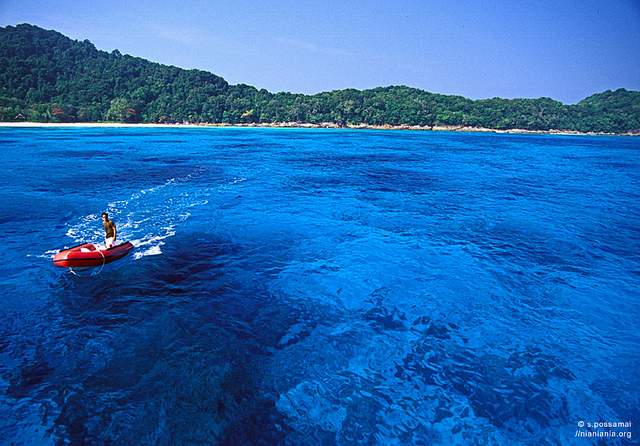I hate the word “undiscovered”. As in “(insert location here) is the next undiscovered paradise!”
It makes me feel like I’m not part of the “in” crowd. The travel elite. (Cue awkward flashback to high school with my bulky JC Penney sweaters and no-name sneakers.)
I mean, how does one go about “discovering” a place anyway? Is there even such a thing? All I know is that by the time I get somewhere, it’s gone through all its phases of (1) undiscovered and only known about by locals, and even then only to the wizened village elders, to (2) a few intrepid backpackers who have swam under caves and braved death battles with komodo dragons to get there, to (3) oops, someone talked about it in an obscure travel forum but was shushed into silence for fear the tourist hordes would come, to (4) a few rustic beach huts with nary a flush toilet to be seen to, finally, (5) full blown tourist mayhem with a 7-11 immediately across the street from another 7-11…
Sigh.
It seems like I’ve been chasing that illusive “perfect” beach since forever. I remember watching the movie Cast Away and all the struggles Tom Hanks experienced trying to get off the island, and thinking to myself that I’d do almost anything to get on that island. Beautifully blissful. Seductively secluded. That was prime real estate, baby (the fact that it was filmed on an uninhabited Fijian island made it all the more drool-worthy…). So while I daydream and read frivolous blogs about Bora Bora and Seychelles and the Maldives, I can only dream about getting to those (supremely expensive) tried-and-true island paradises, dying a little bit inside with each photo.
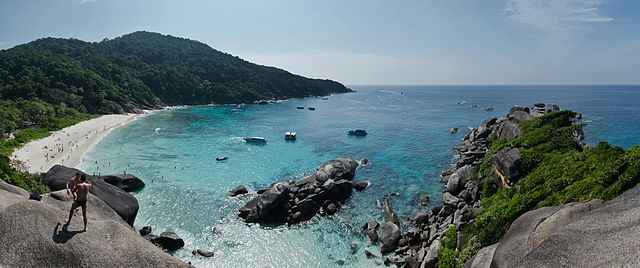
So when I came across an article about the Similans, an uninhabited group of islands about 40 miles (65km) off the coast of Khao Lak, Thailand, my ears perked up. Here was my chance…
Similan is derived from sembilan – Malay for nine, the number of islands which make up the Mu Koh Similan National Park, established in 1982. (Since then, two other islands, Koh Bon and Koh Tachai, have been added.) Islands are known by both names and numbers.
But don’t misunderstand. These islands are not at all undiscovered. Day trippers from Phuket and Khao Lak come in droves, speed boats vomiting hundreds of frolicking swimmers upon the beaches of the two largest islands (tourists are only allowed on the beaches of Islands 4 and 8, the other islands are off limits due to turtle nesting sites) in a steady stream of noise, sun cream, and thongs.
However, the secret of the islands is to stay overnight and have the glorious beaches virtually to yourself in the golden hours before the boats begin arriving at about 11am and after they’ve all departed at about 3pm. Simply magic and worth all the trouble it took to get there to be able to bathe in crystal clear water on the white sand beach (along with all those other overused adjectives like sparkling, electric blue, and powder white — but in this case, totally fitting) with just a handful of other fortunate people, jack fish and flying fish for company. I couldn’t get enough of floating in the gentle, swimming pool-like waters (both islands enjoy a large bay, meaning practically no waves) for hours on end until my fingers got all pruny and wrinkled and even my lips started to feel sunburned.
The perfection of it all inspires the most ridonkulous jumping pictures or skanky Sports Illustrated swimsuit poses. Most people actually let out an audible gasp when they first enter the water, overcome by its sheer beauty. Even the Thai princess has a cabin on Koh Miang, discreetly tucked away on one end of what is now called Princess Bay. Hey. If it’s good enough for a Thai princess, it’s certainly good enough for me. So, Ms. Cheer Caption and Mr. Class President, go ahead and keep your Abercrombie polo and your Benetton jeans, cuz look who’s in with the “cool” crowd now!
Getting there
There are dozens of tour companies that run day trips from both Phuket and Khao Lak. Boats leave from the Thap Lamu Pier, close to Khao Lak. Internet prices are between 2,900-3,500 Baht ($92-$111USD) per day trip (slightly higher if you’re coming from Phuket), leaving the pier at around 9am and returning at about 4pm. The speedboat ride takes about 1.5 hours. The usual itinerary is to make a snorkeling stop before getting to Island 4, spending some beach time on the island with a pre-prepared lunch, before heading off to 1-2 more snorkeling stops and then an hour or so on the beach in Donald Duck Bay on Island 8 (Ko Similan). If you’re not arriving in peak season, you’re better off arranging a trip once in Phuket.
Local shops/restaurants will be able to sell you the tours at a discounted rate. I went with Fantastic Similan and they were very service-oriented, supplying us with food and snacks all day. They even had seasickness pills on hand. (I found the journey quite smooth, not much different from a slightly bumpy car ride, but of course, so much is dependent on the weather.) You may or may not like the over-the-top lady-boy humor, but I found it innocuous enough and occasionally entertaining. A consideration is where the boat stops on Island 4. Larger companies pay higher mooring fees to stop right on the much nicer Princess Bay. Smaller companies stop on the other side of the island, on the much smaller Had Lek beach. (That being said, a short 5-7 minute walk along a jungle path will take you to Princess Bay.) I brought noise-cancelling headphones and an iPod which helped the journey go quickly.
Staying there
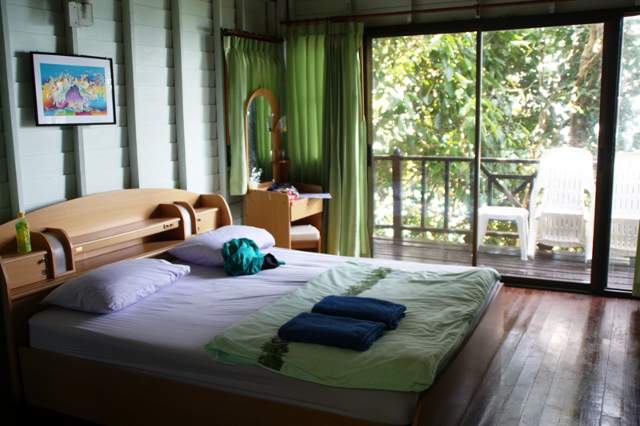
Considering how long it takes to get to the islands (driving + boat = at least 4 hours), definitely think about staying a night or two on the islands. Run by the National Park, there are lodging options on Island 4 and Island 8 (camping only). Island 4 has the whole range of beachside tents (B570 – $18USD)/ night), fan bungalows (B1,000 – $31USD/ night) or a/c bungalows (B2,000 – $62USD/ night). Prices are relatively steep for what you get, but considering this is the only way to stay overnight on the island, there’s not much of an option.
Everything is relatively close to the beach, although the many trees means nothing will have an actual ocean view. You can pre-book and pre-pay through the Thai National Park website, but the payment options are not foreigner-friendly. Payment must be made by bank transfer (easy enough if you’re in Thailand — simply print out your reservation and bring to any Krung Thai bank along with a B50 transfer fee). The website doesn’t tell you in English, but if you reserve for any weekday (Mon – Thu), you’ll get a 40% discount.
The park staff do not speak good English, so anything complicated via email / phone may be problematic. (The first night, the a/c bungalow wasn’t available, so I booked a fan room. Thank goodness my Thai staff was able to help me pay and upgrade to an a/c room later, a headache waiting to happen for all the paperwork required…) I found a company willing to do the financial legwork for a rather steep fee. The park staff also don’t know specifics about each island. When I asked about electricity, they told me it was on all day. When I asked about mosquito nets for the bed, they assured me there were no mosquitoes on the island. No and No. Electricity is only available from 6pm to 6am. And it being a heavily forested island, there are definitely lots of mosquitoes. Big ones. Bring repellent.
Cautionary note: The a/c bungalows were very simple but clean, and I was thankful for the a/c at night. The shower was ok, but the sink spouted foul-smelling well water. I ended up using bottled water to brush my teeth. There was also an issue with bed bugs.
At first I thought they were mosquito bites, but after closer inspection, the telltale cluster of bites in a row confirmed otherwise. If you can take the heat, a tent would probably be the best option. Otherwise, bring along a sleep sack, just in case, for the psychological benefit.
What to eat
There is a small restaurant on Island 4 which mostly caters to tour groups with set meals. Those not on a group tour can buy a-la-carte meals. Breakfast had two options (fry up for B120 – $4USD or shrimp rice congee for B80 – $2.50USD) and for lunch and dinner, there were usually 4 options (starting at B150 – $4.75USD going up to B350 – $11USD for a whole fish dish). Ice cold drinks were B30 (~$1USD). On the whole, food was only passable, though the fish dishes were tasty. I brought a whole rucksack of snacks which kept me happy between meals. A really friendly Thai group kindly adopted me and invited me to share all their meals with them, which was fun.
What to do
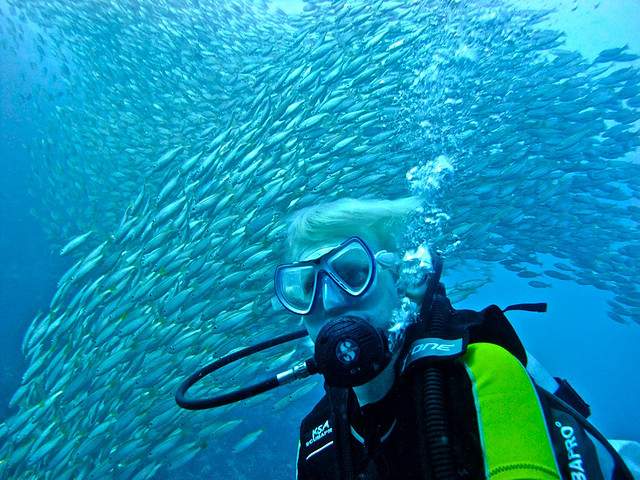
There are three beaches on Island 4 to explore and some easy trails to walk, one leading up to a viewpoint. There is some snorkeling off the beach (some large parrot fish, but hardly any coral.) Additionally, the park rangers run a half-day snorkeling tour for only B200 ($6.50USD) , going to some of the nearby islands. The morning I did it, there was just me and one girl from my adopted Thai family, so the two of us had our own private tour, led by two of the park rangers. It was nice having a guide who was able to point out an octopus and some small mantas. The highlights were having a sea turtle swim about a meter below me and a school of about 70 blue tangs playing “follow the leader.”
The snorkeling spots were about 4-6 meters deep with excellent visibility down to the sea bed. There has been lots of talk about coral bleaching. While I hardly saw any soft coral, the number and variety of marine life was quite good.
What to expect
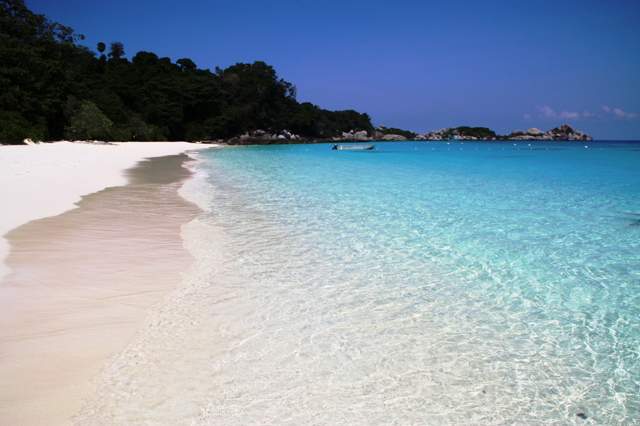
These are largely uninhabited islands, completely closed between May 1 and November 1. Wild animals run free. Trees are filled with screeching bats. There was a baby python curled up in the restaurant rafters one morning and large monitor lizards scurried across jungle paths. Just think of the whole experience as glorified camping… or maybe not even that glorified, come to think of it. But then again, every Eden has its poisoned fruit (in this case, bed bugs and pythons). Overall, though, a small price to pay for a slice of paradise… don’t forget to bring lip balm. The sun is intense and there’s little shade on the beach, but seriously, you wouldn’t want to be anywhere else.
Alternatives
Another option for those who don’t want to just day-trip is the liveaboard. This is a larger, slower boat with cabins or dorms and will include all your food and activities for 2-3 nights.
Usually for divers (the Similan was rated one of the world’s top 10 dive sites by National Geographic), there are increasingly more liveaboards aimed at snorkelers. The beauty of this option is being able to see most of the Similans, including the farther islands of Koh Bon and Koh Tachai as well as the next group of gorgeous islands, the Surins, which would otherwise mean three separate and time-consuming day trips. The liveaboards moor just off shore with a small rubber boat ferrying guests to enjoy the beaches in the late afternoons. Definitely an option I’d consider next time.
Check out the following articles and resources about traveling in Thailand:
- Find a cheap flight to Bangkok
- Check out our Thailand Indie Travel Guide
- Find an adventure trip in Thailand
- Read 7 Sustainable Ways to Dive into Thai Culture
- Read Paradise on a Budget: Eco Retreats the Won’t Break the Bank
- Read How to Plan an Extended Trip in Southeast Asia
To read more from James Pham, check out his author bio.
Photo credits: Mathias Krumbholz; all photos courtesy of the author and may not be used without permission.
